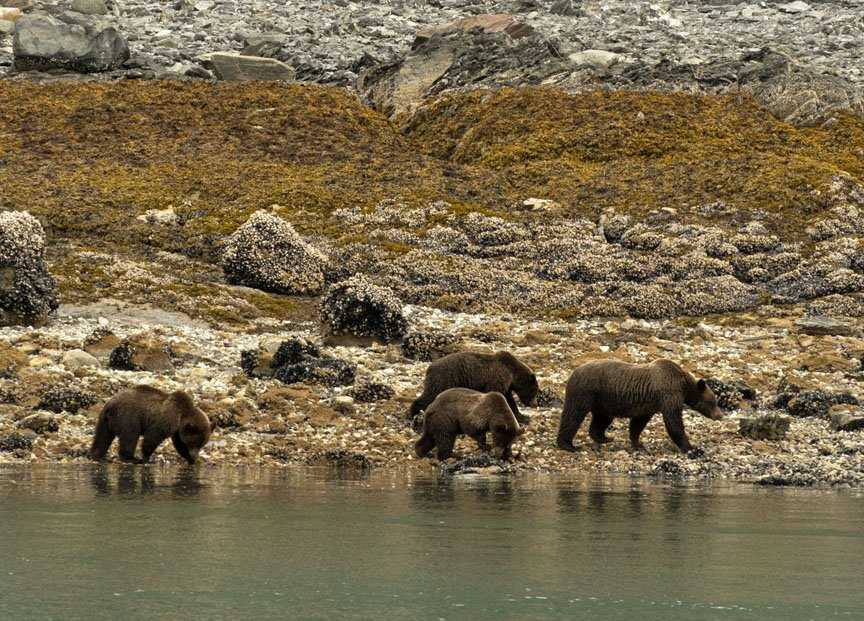The bow of the National Geographic Sea Lion had quite a crowd this morning at 5:00 AM as our ship approached Jaw Point. The weather had changed from clear skies to high clouds. The morning air was completely still with reflections of mountains, glaciers and clouds and sky bouncing back to everyone on the bow. The plan was to spend the early morning cruising the five-mile fjord leading up to the face of Johns Hopkins Glacier. Slowly, the sun began to light our world changing the early day’s colors from blues and grays to warmer tones of a sunlit day.
Just after 6:00 AM we were comfortably one-quarter mile off of the face of Johns Hopkins Glacier. The shape of the fjord created a wonderful echo from each calving we watched sprinkle down into the sea. The mountains all around were dusted with this year’s first snow, a sign that the warm days of summer had quickly moved into fall. We remained in front of this great wall of ice until breakfast and then slowly the Sea Lion began a slow retreat back out into Tarr Inlet and a slow journey south.
As we moved into Russell Cut, our first wildlife of the day was spotted. A lone wolf was making its way across an alluvial fan doing what wolves do, move, hunt, while covering their extensive territory. Further south in Tarr Inlet, the Sea Lion began a slow approach to Gloomy Knob and almost immediately mountain goats were spotted laying about on the rocks! Maneuvering slowly our officers on the bridge brought us in close for wonderful looks at several animals relaxing high above the water’s edge.
As we began our departure from Gloomy Knob, the natural history staff made a slow pass around the bow of the Sea Lion encouraging everyone to be observant and just a little bit quiet. As the staff had hoped, once around the corner a staff member made the call to the bridge, “Bear, bear, bear.” Slowly we rounded the corner and bear after bear came into view! Along a newly established salmon stream there were three solo bears along with a sow and three cubs, then just down the beach another sow and three cubs and then just around the corner in Tidal Inlet two more solo bears were spotted for a total of 12 bears! Staff, crew and guests were all around the available decks watching this extraordinary wildlife display!
Slowly the Sea Lion pulled away and began moving south heading for South Marble, our last stop of the afternoon. This small island was alive with sea birds and Steller sea lions. We were all treated to a cacophony of bird and sea lion sounds as we moved slowly past birds soaring and sea lions crowded onto small haul outs in a very high tide. General commotion everywhere! Cameras could be heard clicking, and once again we moved south heading for an appointment with Bartlett Cove and a once in a life time opportunity to be some of the first public guests to view the recently opened Tlingit Tribal Clan House.
At approximately 3:45 PM we were docked and ready to disembark making our way a short distance through the woods to the front of a traditionally built Tlingit Clan House. Gary Brown, our Tlingit cultural interpreter, held our attention as the intricate, complicated and beautifully carved stories on the front of the Tribal Clan House came to life through his words. Once inside many of us were overcome with emotion as we stood in awe at the beauty that had been so carefully carved, honoring all Tlingit people who still call Glacier Bay their homeland.
The Wooshkeetaan (shark clan), Kaagwaataan (wolf clan), Chookaneidi (porpoise clan) and T’akdeintaan (kittiwake clan) were all represented in the four House Posts that are the central part of the house construction. Gary answered questions, told stories and shared much about the importance of the building of this clan house called: Xunnaa Shuka Hit, roughly translated as “Huna Ancestor’s House stands.” As we listened, watched and photographed the light clouds that had been over us all day began to lift. Early evening sunlight filled the sky along with eagles and ravens all calling to us as we made our way into the young forest that surrounds the Glacier Bay Lodge.
In the spring of 1794, Captain George Vancouver was cruising and charting the northern waters of Southeast Alaska. When he arrived at the area we now stood on, he found, rather than a bay and forest, a massive tidewater glacier and aptly named the area “Icy Strait.” Imagine what he might have thought if he were to walk in our shoes this evening. Only two centuries later, Grand Pacific Glacier has retreated 60 miles up the bay creating some of the most impressive wild scenery in North America.
The Tlingit people, both the old ones and Tlingit today, know the beauty of their homeland, and we as guests are also witnesses to the collaboration between the Huna Tlingit and the National Park Service. Inside the house each exquisite carving spoke to us, calling out its origin myth. We were reminded of a world very different from ours; and a world whose inhabitants, the Tlingit, had opened their “Box of Knowledge” to share. We were moved and honored as we walked away into the brightly lit evening light.






